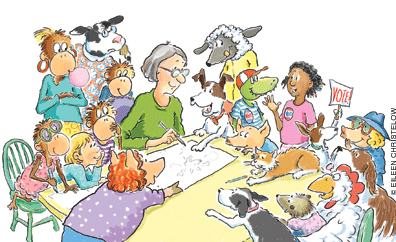
Class of ’65 | It started with a plucky rabbit, followed closely by a scholarly pig. Dogs, opossums, and alligators have also provided inspiration, but it wasn’t until she tossed five rambunctious little monkeys onto a bed that Eileen Christelow C’65 became a household name in children’s literature.
“I love the monkeys,” the writer/illustrator says of her popular picture-book series, which includes Five Little Monkeys Jumping on the Bed (1989), Five Little Monkeys Go Shopping (2007), and five other titles in between. “I think that kids really identify with them. They’re really naughty, but they’re also pretty nice.”
In August, Christelow’s monkeys leapt into the Five Little Monkeys Storybook Treasury—a 20th-anniversary edition that includes five previously published Monkey tales and marks the 26th animal-packed picture book she’s had published.
You could say the monkeys found her. More than three decades ago, Christelow learned the well-known “Five Little Monkeys Jumping on the Bed” and “Five Little Monkeys Sitting in a Tree” rhymes from her daughter, Heather, who was in kindergarten at the time.
“I was trying to be an illustrator of children’s books, and I took ‘Sitting in a Tree’ and did some illustrations for it,” she says. “They became part of my portfolio, but I didn’t want to use it as a whole book.”
But Christelow couldn’t quite get those singsong rhymes out of her head, and a decade later she found herself revisiting them.
“I was rooting around for an idea and I thought ‘Sitting on a Tree’ seemed like too violent a rhyme, so I decided to try putting ‘Jumping on the Bed’ into a book.” Realizing that the monkeys and their bed-hopping obsession needed context, she decided to set the scene at bedtime.
“The drawings were really what made the book work,” she says. “As I drew the monkeys, I got a sense of what each of their personalities would be.” She concluded the tale with a twist that had both grown-ups and kids smiling: mama monkey jumping on the bed. “I wanted to end it with the poor mama who’s been calling the doctor every five minutes. I thought it was a lot of fun, and parents thought it was a lot of fun, and kids thought it was a lot of fun, too.” In the end, the same rhymes Heather had learned as a child helped pay her college tuition.
As an undergraduate at Penn, Christelow was on her way to a career in architecture. But after several drawing and graphics classes, she ditched her protractor and went to work as a freelance photographer. Nearly a decade later, she found herself making frequent trips to the public library with then-toddler Heather. They would cart home picture books by the pile.
“I started thinking, ‘Well, maybe I could start drawing again,’ so I started with an alphabet book,” she recalls. “I learned a lot while drawing that because I didn’t have to worry about plot.”
Her big break came on a trip to New York City in 1981. She and her husband had just moved back to the East Coast from California and they needed money: it was time to start translating her passion into income. Jim Giblin, an editor at Clarion Books (an imprint of Houghton Mifflin), agreed to buy Henry and the Red Stripes (1982) and option Mr. Murphy’s Marvelous Invention (1983). He’s been her editor ever since.
“It was fresh and funny,” Giblin says of Henry, which tells the story of a rabbit who de-camouflages himself with red stripes and is unable to hide when a fox comes along. (Don’t worry, there’s a happy ending.) “Eileen had a nice sense of humor, and there was an imaginative story there. She always comes up with unusual stories that also have a good plot.”
She’s also dabbled in non-fiction picture books, with titles that include What Do Authors Do? (1995) and What Do Illustrators Do? (1999). While appearing at schools during the 2000 presidential campaign season, Christelow was impressed by students’ interest in the election. She asked the teachers if there were any books they could use to talk about voting, and when they said there weren’t, she wrote her own. Vote! reveals the process and history of voting through a character whose mother is running for mayor. It first appeared in time for the 2004 presidential election, and was so successful that Clarion re-released it in February 2008.
Of the 25 picture books she’s created, Christelow counts Vote! as one of her best because it breezily breaks down sophisticated subject matter. “I enjoy using picture books as a format to explain complicated ideas,” she says. “Picture books have a real economy of words, and writing one is a lot like writing a poem: They’re short and they look really easy, but they’re not.” Vote! also exemplifies her insistence on treating children as equals, an approach that may explain why her books have earned accolades like Smithsonian Notable Book for Children, International Reading Association and Children’s Book Council Children’s Choice, and Reading Rainbow feature book. “I’m not trying to write for children specifically,” she says. “A lot of people make the mistake of thinking, ‘Oh, it’s for kids. It’s simple.’ I think that’s demeaning to kids. It’s also not what the best children’s literature is about.”
—Molly Petrilla C’06




